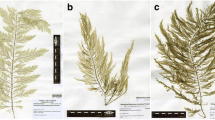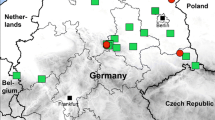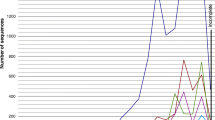Abstract
Warming of Arctic and alpine regions has a substantial impact on high-altitude/-latitude ecosystems. Shifting biomes due to climate change may lead to adjustments in species distributions and potential extinctions. Therefore, detailed monitoring is requisite to assess biologically meaningful shifts in community composition and species distributions. Some Arctic-alpine lichens have been shown to be particularly sensitive to climatic shifts associated with global change. However, accurate identification of lichenized fungal species remains challenging and may limit the effective use of lichens in climate change research. Given the inherent difficulties in accurate identification of lichenized fungi and the potential value of efficient identifications for bio-monitoring research, we investigated the utility of DNA barcode identification of the 13 brown Parmeliae (Ascomycota) species occurring in Greenland. For these species, we assessed monophyly and genetic distances using the nuclear ribosomal internal transcribed spacer region (ITS), the standard DNA barcode for fungi. We also compared intraspecific distance values to a proposed intra-interspecific threshold value for Parmeliaceae to identify nominal taxa potentially masking previously unrecognized diversity. Our results indicated that the 13 brown Parmeliae species occurring in Greenland can be successfully discriminated using the ITS region. All phenotypically circumscribed species were recovered as well-supported, monophyletic clades. Furthermore, our data supported a barcode gap among congeners for all brown Parmeliae species investigated here. However, high intraspecific genetic distances suggest the potential for previously unrecognized species-lineages in at least five species: Melanelia agnata, M. hepatizon, Montanelia disjuncta, M. panniformis, and M. tominii. Our research facilitates effective, long-term bio-monitoring of climate change in Greenland using lichens by providing accurate molecular identification of brown Parmeliae specimens.


Similar content being viewed by others
References
Aitken, S. N., Yeaman, S., Holliday, J. A., Wang, T. L., & Curtis-McLane, S. (2008). Adaptation, migration or extirpation: climate change outcomes for tree populations. Evolutionary Applications, 1(1), 95–111. doi:10.1111/j.1752-4571.2007.00013.x.
Araújo, M. B., & Rahbek, C. (2006). How does climate change affect biodiversity? Science, 313(5792), 1396–1397. doi:10.1126/science.1131758.
Arup, U., & Berlin, E. S. (2011). A taxonomic study of Melanelixia fuliginosa in Europe. The Lichenologist, 43, 89–97. doi:10.1017/S0024282910000678.
Baird, D. J., & Hajibabaei, M. (2012). Biomonitoring 2.0: a new paradigm in ecosystem assessment made possible by next-generation DNA sequencing. Molecular Ecology, 21, 2039–2044. doi:10.1111/j.1365-294X.2012.05519.x.
Bässler, C., Müller, J., & Dziock, F. (2010). Detection of climate-sensitive zones and identification of climate change indicators: a case study from the Bavarian Forest National Park. Folia Geobotanica, 45, 163–182. doi:10.1007/s12224-010-9059-4.
Beck, P. S. A., Juday, G. P., Alix, C., Barber, V. A., Winslow, S. E., Sousa, E. E., et al. (2011). Changes in forest productivity across Alaska consistent with biome shift. Ecology Letters, 14, 373–379.
Begerow, D., Nilsson, H., Unterseher, M., & Maier, W. (2010). Current state and perspectives of fungal DNA barcoding and rapid identification. Applications in Microbiology and Biotechnology, 97, 99–108.
Bjerke, J. W. (2011). Winter climate change: Ice encapsulation at mild subfreezing temperatures kills freeze-tolerant lichens. Environmental and Experimental Botany, 72, 404–408. doi:10.1016/j.envexpbot.2010.05.014.
Blanco, O., Crespo, A., Divakar, P. K., Esslinger, T. L., Hawksworth, D. L., & Thorsten Lumbsch, H. (2004a). Melanelixia and Melanohalea, two new genera segregated from Melanelia (Parmeliaceae) based on molecular and morphological data. Mycological Research, 108(8), 873–884. doi:10.1017/S0953756204000723.
Blanco, O., Crespo, A., Elix, J. A., Hawksworth, D. L., & Lumbsch, H. T. (2004b). A molecular phylogeny and a new classification of parmelioid lichens containing Xanthoparmelia-type lichenan (Ascomycota: Lecanorales). Taxon, 53, 959–975.
Bradshaw, W. E., & Holzapfel, C. M. (2006). Evolutionary response to rapid climate change. Science, 312, 1477–1478. doi:10.1126/science.1127000.
Chase, M. W., & Fay, M. F. (2009). Barcoding of plants and fungi. Science, 325, 682–683. doi:10.1126/science.1176906.
Collins, R. A., & Cruickshank, R. H. (2012). The seven deadly sins of DNA barcoding. Molecular Ecology Resources, in press, doi:10.1111/1755-0998.12046.
Cornelissen, J. H. C., Callaghan, T. V., Alatalo, J. M., Michelsen, A., Graglia, E., Hartley, A. E., et al. (2001). Global change and arctic ecosystems: is lichen decline a function of increases in vascular plant biomass? Journal of Ecology, 89, 984–994.
Crespo, A., Kauff, F., Divakar, P. K., del Prado, R., Perez-Ortega, S., Amo de Paz, G., et al. (2010). Phylogenetic generic classification of parmelioid lichens (Parmeliaceae, Ascomycota) based on molecular, morphological and chemical evidence. Taxon, 59, 1735–1753.
Crespo, A., & Lumbsch, H. T. (2010). Cryptic species in lichen-forming fungi. IMA Fungus, 1, 167–170.
Crespo, A., Lumbsch, H. T., Mattsson, J.-E., Blanco, O., Divakar, P. K., Articus, K., et al. (2007). Testing morphology-based hypotheses of phylogenetic relationships in Parmeliaceae (Ascomycota) using three ribosomal markers and the nuclear RPB1 gene. Molecular Phylogenetics and Evolution, 44, 812–824. doi:10.1016/j.ympev.2006.11.029.
Crespo, A., & Pérez-Ortega, S. (2009). Cryptic species and species pairs in lichens: a discussion on the relationship between molecular phylogenies and morphological characters. Anales del Jardín Botánico de Madrid, 66(S1), 71–81.
Culberson, C. F. (1972). Improved conditions and new data for identification of lichen products by standardized thin-layer chromatographic method. Journal of Chromatography A, 72, 113–125. doi:10.1016/0021-9673(72)80013-X.
Del-Prado, R., Cubas, P., Lumbsch, H. T., Divakar, P. K., Blanco, O., de Paz, G. A., et al. (2010). Genetic distances within and among species in monophyletic lineages of Parmeliaceae (Ascomycota) as a tool for taxon delimitation. Molecular Phylogenetics and Evolution, 56, 125–133. doi:10.1016/j.ympev.2010.04.014.
Dillman, K. L. (1996). Use of the lichen Rhizoplaca melanophthalma as a biomonitor in relation to phosphate refineries near Pocatello, Idaho. Environmental Pollution, 92, 91–96. doi:10.1016/0269-7491(95)00084-4.
Dirnböck, T., Dullinger, S., & Grabherr, G. (2003). A regional impact assessment of climate and land-use change on alpine vegetation. Journal of Biogeography, 30, 401–417. doi:10.1046/j.1365-2699.2003.00839.x.
Divakar, P. K., Del-Prado, R., Lumbsch, H. T., Wedin, M., Esslinger, T. L., Leavitt, S. D., et al. (2012). Diversification of the newly recognized lichen-forming fungal lineage Montanelia (Parmeliaceae, Ascomycota) and its relation to key geological and climatic events. American Journal of Botany, 99, 2014–2026. doi:10.3732/ajb.1200258.
Divakar, P. K., Figueras, G., Hladun, N., & Crespo, A. (2010). Molecular phylogenetic studies reveal an undescribed species within the North American concept of Melanelixia glabra (Parmeliaceae). Fungal Diversity, 42, 47–55. doi:10.1007/s13225-010-0027-3.
Elix, J. A. (1993). Progress in the generic delimitation of Parmelia sensu lato lichens (Ascomycotina: Parmeliaceae) and a synoptic key to the Parmeliaceae. The Bryologist, 96, 359–383.
Esslinger, T. L. (1977). A chemosytematic revision of the brown Parmeliae. Journal of Hattori Botanical Laboratory, 42, 1–211.
Esslinger, T. L. (1978). A new status for brown Parmeliae. Mycotaxon, 7, 45–54.
Fujita, M. K., Leaché, A. D., Burbrink, F. T., McGuire, J. A., & Moritz, C. (2012). Coalescent-based species delimitation in an integrative taxonomy. Trends in Ecology & Evolution, 9, 480–488. doi:10.1016/j.tree.2012.04.012.
Hansen, E. S. (1995). Greenland Lichens. Atuagkat & Rhodos in cooperation with the Danish Polar Center. Copenhagen. 124 pp.
Hansen, E. S. (2009). Lichens from Johannes V. Jensen Land, N Greenland, the northernmost arctic land area. Willdenowia, 39, 179–186.
Hansen, E. S. (2010). Lichens from five inland and coastal localities in south-west Greenland and their present climatic preferences in Greenland as regards oceanity and continentality. Bibliotheca Lichenologica, 104, 143–154.
Hansen, E. S. (2011a). Qaanaaq og Siorapaluk - laver og natur i et ændret klima. Tidsskriftet Grønland, 2(2011), 136–149.
Hansen, E. S. (2011b). Lichens from Qaanaaq and Siorapaluk, Northwest Greenland. Folia Cryptogamica Estonia, 48, 4–11.
Hansen, E. S. (2012a). Lichens from five localities in south-east Greenland and their exposure to climate change. Bibliotheca Lichenologica, 108, 123–134.
Hansen, E. S. (2012b). Hvad fortæller laverne on klimaet ved Zackenberg. Tidsskriftet Grønland, 1(2012), 42–51.
Hansen, K. (1971). Lichens in South Greenland, distribution and ecology. Meddelelser om Grønland, 178, 1–84.
Jackson, S. T., & Overpeck, J. T. (2000). Responses of plant populations and communities to environmental changes of the late Quaternary. Paleobiology, 26, 194–220.
Jägerbrand, A., Lindblad, K. M., Björk, R., Alatalo, J., & Molau, U. (2006). Bryophyte and lichen diversity under simulated environmental change compared with observed variation in unmanipulated alpine tundra. Biodiversity and Conservation, 15, 4453–4475. doi:10.1007/s10531-005-5098-1.
Jensen, L. M. ed. (2012). Zackenberg Ecological Research Operations, 17th Annual Report, 2011. Aarhus University, DCE - Dannish Center for Environment and Energy. 120 pp.
Kelly, L. J., Hollingsworth, P. M., Coppins, B. J., Ellis, C. J., Harrold, P., Tosh, J., et al. (2011). DNA barcoding of lichenized fungi demonstrates high identification success in a floristic context. New Phytologist, 191, 288–300. doi:10.1111/j.1469-8137.2011.03677.x.
Kortsch, S., Primicerio, R., Beuchel, F., Renaud, P. E., Rodrigues, J., Lønne, O. J., et al. (2012). Climate-driven regime shifts in Arctic marine benthos. Proceedings of the National Academy of Sciences, 109, 14052–14057. doi:10.1073/pnas.1207509109.
Kristinsson, H., Zhurbenko, M., & Hansen, E. S. (2010). Panarctic checklist of lichens and lichenicolous fungi. CAFF Technical Report No. 20. Akureyri, Iceland: CAFF International Secretariat.
Larena, I., Salazar, O., González, V., Julián, M. C., & Rubio, V. (1999). Design of a primer for ribosomal DNA internal transcribed spacer with enhanced specificity for ascomycetes. Journal of Biotechnology, 75, 187–194. doi: 10.1016/s0168-1656(99)00154-6
Leavitt, S., Esslinger, T. L., Divakar, P. K., & Lumbsch, H. (2012a). Miocene and Pliocene dominated diversification of the lichen-forming fungal genus Melanohalea (Parmeliaceae, Ascomycota) and Pleistocene population expansions. BMC Evolutionary Biology, 12, 176.
Leavitt, S. D., Esslinger, T. L., Divakar, P. K., & Lumbsch, H. T. (2012b). Miocene divergence, phenotypically cryptic lineages, and contrasting distribution patterns in common lichen-forming fungi (Ascomycota: Parmeliaceae). Biological Journal of the Linnean Society, 1007, 920–937.
Leavitt, S. D., Fernández-Mendoza, F., Pérez-Ortega, S., Sohrabi, M., Divakar, P. K., Lumbsch, H. T., et al. (2013a). DNA barcode identification of lichen-forming fungal species in the Rhizoplaca melanophthalma species-complex (Lecanorales, Lecanoraceae), including five new species MycoKeys, 7, 1–22. doi:10.3897/mycokeys.7.4508.
Leavitt, S. D., Esslinger, T. L., Spribille, T., Divakar, P. K., & Lumbsch, H. T. (2013b). Multilocus phylogeny of the lichen-forming fungal genus Melanohalea (Parmeliaceae, Ascomycota): Insights on diversity, distributions, and a comparison of species tree and concatenated topologies. Molecular Phylogenetics and Evolution, 66, 138–152. doi:10.1016/j.ympev.2012.09.013.
Leavitt, S. D., & St. Clair, L. L. (2011). Estimating Xanthoparmelia (Parmeliaceae) population density in subalpine communities in southern Utah, U.S.A. using two distance methods, with implications for assessing community composition. The Bryologist, 114, 625–636. doi:10.1639/0007-2745-114.3.625.
Longton, R. E. (1997). The role of bryophytes and lichens in polar ecosystems. In S. J. Woodin & M. Marquiss (Eds.), The Arctic: Environment, People, Policy (pp. 69–96). Oxford: Blackwell Science.
Lumbsch, H. T., & Leavitt, S. D. (2011). Goodbye morphology? A paradigm shift in the delimitation of species in lichenized fungi. Fungal Diversity, 50, 59–72. doi:10.1007/s13225-011-0123-z.
Manel, S., Joost, S., Epperson, B. K., Holderegger, R., Storfer, A., Rosenberg, M. S., et al. (2010). Perspectives on the use of landscape genetics to detect genetic adaptive variation in the field. Molecular Ecology, 19, 3760–3772.
McCune, B. (2000). Lichen Communities as Indicators of Forest Health. The Bryologist, 103(2), 353–356.
Medinger, R., Nolte, V., Pandey, R. V., Jost, S., Ottenwäder, B., Schlötterer, C., et al. (2010). Diversity in a hidden world: potential and limitation of next-generation sequencing for surveys of molecular diversity of eukaryotic microorganisms. Molecular Ecology, 19, 32–40. doi:10.1111/j.1365-294X.2009.04478.x.
Monaghan, M. T., Wild, R., Elliot, M., Fujisawa, T., Balke, M., Inward, D. J. G., et al. (2009). Accelerated species inventory on Madagascar using coalescent-based models of species delineation. Systematic Biology, 58, 298–311. doi:10.1093/sysbio/syp027.
Nelsen, M. P., Chavez, N., Sackett-Hermann, E., Thell, A., Randlane, T., Divakar, P. K., et al. (2011). The cetrarioid core group revisited (Lecanorales: Parmeliaceae). The Lichenologist, 43, 537–551. doi:10.1017/S0024282911000508.
Nilsson, R. H., Ryberg, M., Kristiansson, E., Abarenkov, K., Larsson, K.-H., & Kõljalg, U. (2006). Taxonomic reliability of DNA sequences in public sequence databases: a fungal perspective. PLoS One, 1, e59.
O'Brien, H. E., Parrent, J. L., Jackson, J. A., Moncalvo, J.-M., & Vilgalys, R. (2005). Fungal community analysis by large-scale sequencing of environmental samples. Applied and Environmental Microbiology, 71, 5544–5550. doi:10.1128/aem.71.9.5544-5550.2005.
Orange, A., James, P. W., & White, F. J. (2001). Microchemical methods for the identification of lichens. London: British Lichen Society.
Orock, E. A., Leavitt, S. D., Fonge, B. A., St. Clair, L. L., & Lumbsch, H. T. (2012). DNA-based identification of lichen-forming fungi: Can publicly available Sequence databases aid in lichen diversity inventories of Mount Cameroon (West Africa)? The Lichenologist, 44, 833–839. doi:10.1017/S0024282912000424.
Otte, V., Esslinger, T. L., & Litterski, B. (2005). Global distribution of the European species of the lichen genus Melanelia Essl. Journal of Biogeography, 32, 1221–1241. doi:10.1111/j.1365-2699.2005.01268.x.
Parmesan, C., & Yohe, G. (2003). A globally coherent fingerprint of climate change impacts across natural systems. [10.1038/nature01286]. Nature, 421, 37–42, doi:http://www.nature.com/nature/journal/v421/n6918/suppinfo/nature01286_S1.html.
Pino-Bodas, R., Martin, A. P., Burgaz, A. R., & Lumbsch, H. T. (2013). Species delimitation in Cladonia (Ascomycota): a challenge to the DNA barcoding philosophy. Molecular Ecology Resources. doi:1111/1755-0998.12086.
Post, E., Forchhammer, M. C., Bret-Harte, M. S., Callaghan, T. V., Christensen, T. R., Elberling, B., et al. (2009). Ecological dynamics across the Arctic associated with recent climate change. Science, 325, 1355–1358. doi:10.1126/science.1173113.
Schoch, C. L., Seifert, K. A., Huhndorf, S., Robert, V., Spouge, J. L., Levesque, C. A., et al. (2012). Nuclear ribosomal internal transcribed spacer (ITS) region as a universal DNA barcode marker for Fungi. Proceedings of the National Academy of Sciences, 109, 6241–6246. doi:10.1073/pnas.1117018109.
Serreze, M. C., Walsh, J. E., Chapin, I. F. S., Osterkamp, T., Dyurgerov, M., Romanovsky, V., et al. (2000). Observational evidence of recent change in the northern high-latitude environment. Climatic Change, 46, 159–207.
Stamatakis, A. (2006). RAxML-VI-HPC: maximum likelihood-based phylogenetic analyses with thousands of taxa and mixed models. Bioinformatics, 22, 2688–2690. doi:10.1093/bioinformatics/btl446.
Stamatakis, A., Hoover, P., & Rougemont, J. (2008). A Rapid Bootstrap Algorithm for the RAxML Web Servers. Systematic Biology, 57, 758–771. doi:10.1080/10635150802429642.
Strum, M., Racine, C., & Tapes, K. (2001). Climate change: Increasing shrub abundance in the Arctic. Nature, 411, 546–547.
Swofford, D. (2002). PAUP. Phylogenetic Analysis Using Parsimony (* and Other Methods), version 4.0b10. Verson 4 edn.
Sykes, M. T., Prentice, I. C., & Laarif, F. (1999). Quantifying the impact of global climate change on potential natural vegetation. Climatic Change, 41, 37–52.
Thell, A., Crespo, A., Divakar, P. K., Kärnefelt, I., Leavitt, S. D., Lumbsch, H. T., et al. (2012). A review of the lichen family Parmeliaceae – history, phylogeny and current taxonomy. Nordic Journal of Botany, 30, 641–664. doi:10.1111/j.1756-1051.2012.00008.x.
Thell, A., Högnabba, F., Elix, J. A., Feuerer, T., Kärnefelt, I., Myllys, L., et al. (2009). Phylogeny of the cetrarioid core ( Parmeliaceae) based on five genetic markers. The Lichenologist, 41, 489–511. doi:10.1017/S0024282909990090.
Thell, A., Feuerer, T., Kärnefelt, I., Myllys, L., & Stenroos, S. (2004). Monophyletic groups within the Parmeliaceae identified by ITS rDNA, β-tubulin and GAPDH sequences. Mycologogical Progress, 3, 297–314. doi:10.1007/s11557-006-0100-1.
Van Wijk, M. T., Clemmensen, K. E., Shaver, G. R., Williams, M., Callaghan, T. V., Chapin, F. S., et al. (2004). Long-term ecosystem level experiments at Toolik Lake, Alaska, and at Abisko, Northern Sweden: generalizations and differences in ecosystem and plant type responses to global change. Global Change Biology, 10, 105–123. doi:10.1111/j.1365-2486.2003.00719.x.
Wheeler, D. L., Barrett, T., Benson, D. A., Bryant, S. H., Canese, K., Chetvernin, V., et al. (2006). Database resources of the National Center for Biotechnology Information. Nucleic Acids Research, gkl1031, doi:10.1093/nar/gkl1031.
Whinam, J., & Copson, G. (2006). Sphagnum moss: an indicator of climate change in the sub-Antarctic. Polar Record, 42, 43–49. doi:10.1017/S0032247405004900.
White, T. J., Bruns, T., Lee, S., & Taylor, J. (1990). Amplification and direct sequencing of fungal ribosomal RNA genes for phylogenetics. In N. Innis, D. Gelfand, J. Sninsky, & T. J. White (Eds.), PCR protocols (pp. 315–322). San Diego: Academic Press.
Acknowledgments
We are indebted to various colleagues for providing valuable material and field assistance, notably, Jarle Bjerke, Curtis Björk, Trevor Goward, Ann Henson, Jason Holzinger, Chris and Donna Howell, Kerry Knudsen, the Leavitt family, James Lendemer, Bruce McCune, Troy McMullin, Tom Nash, Toby Spribille, Larry St. Clair, and Arne Thell. We thank the following individuals for making invaluable contributions in the laboratory: Kevin Feldheim, Sergio Garcia, Warren Chatwin, and Jessica Allen. We also thank Curtis Björk, Jason Hollinger, Chris Parrish, and Einar Timdal for generously allowing us to use their photographs, and Monica Proulx for her helpful comments. Support from the National Science Foundation (“Hidden diversity in parmelioid lichens,” DEB-0949147), Negaunee Foundation, and Ministerio de Ciencia e Innovación, Spain (GLCL2010-21646/BOS), is gratefully acknowledged.
Author information
Authors and Affiliations
Corresponding author
Electronic Supplementary Materials
Below is the link to the electronic supplementary material.
Supplementary Table S1
Collection information for all brown Parmeliae specimens included in the present study (XLSX 46 kb)
Supplementary Figure S1
Maximum likelihood ITS phylogeny of 372 samples brown Parmeliaespecimens. Non-parametric bootstrap support is indicated at nodes (PDF 405 kb)
Rights and permissions
About this article
Cite this article
Leavitt, S.D., Esslinger, T.L., Hansen, E.S. et al. DNA barcoding of brown Parmeliae (Parmeliaceae) species: a molecular approach for accurate specimen identification, emphasizing species in Greenland. Org Divers Evol 14, 11–20 (2014). https://doi.org/10.1007/s13127-013-0147-1
Received:
Accepted:
Published:
Issue Date:
DOI: https://doi.org/10.1007/s13127-013-0147-1




